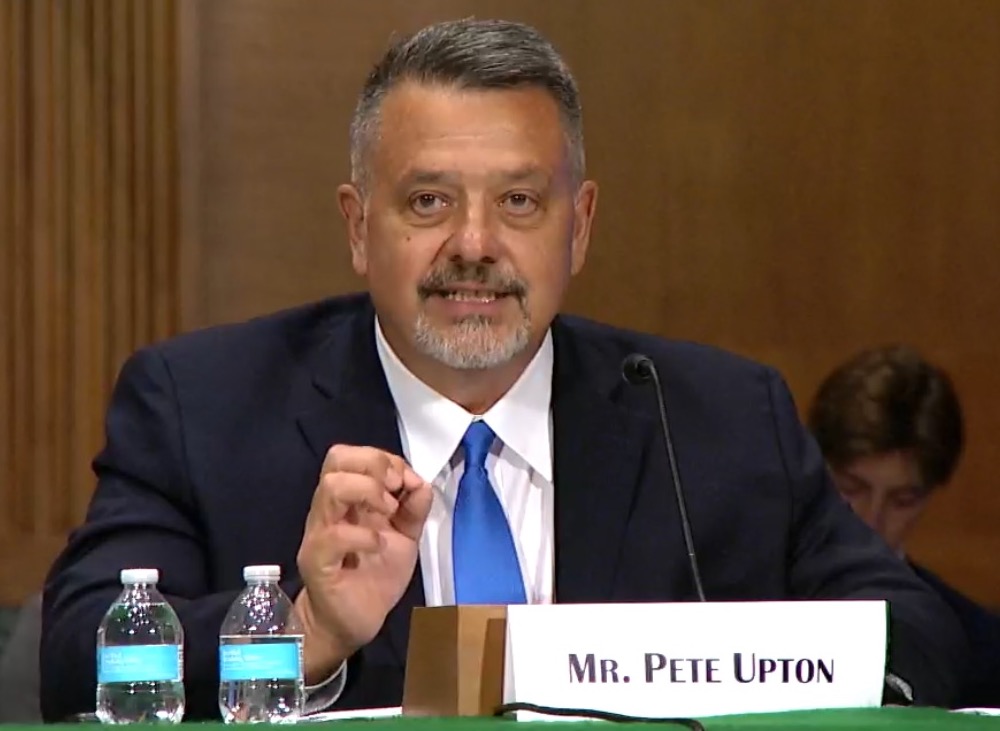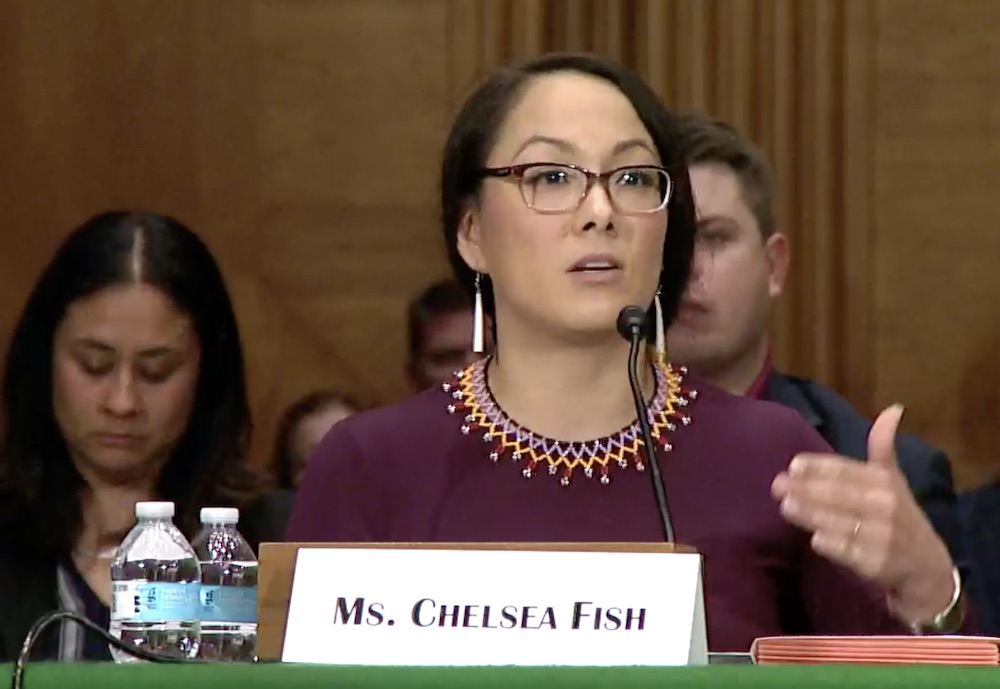
- Details
- By Chez Oxendine
- Real Estate
WASHINGTON—Discussion during a Senate subcommittee hearing yesterday was largely friendly, if insistent, conversation about issues facing housing in Indian Country — including safety, grant money spent on remediation instead of new housing development, and underfunded technical assistance programs bound by yards of red tape.
Later in the hearing, however, Native Community Development Financial Institution (CDFI) Network CEO Pete Upton succinctly expressed his frustration with a system that invited CDFIs like the ones he advocates for to participate in HUD 184 home loans without the necessary funding to support it.
“The number one challenge that Native CDFIs face in helping people get homes is lack of capital — we can't be lenders without the appropriate capital,” Upton told the committee. “You're inviting us to a game that we can't play.”
Throughout the 75-minute hearing, led by Chair Tina Smith (D-MN) and Ranking Member Cynthia Lummis (R-WY), Upton and three other panelists highlighted the challenges they’ve encountered working with federal agencies, their thoughts on ways tribal housing programs can be improved, and the barriers to homeownership on tribal lands.
National American Indian Housing Council Executive Director Chelsea Fish noted that roughly half of Native Americans own homes. Nearly 16% of those homeowners face overcrowding issues, she said, packing multiple families into two or three bedroom residences.
“I remember growing up in one of the poorest counties in Oklahoma as a little girl in my grandmother’s house (in) Johnston County,” Fish said. “We grew up living in a very overcrowded home in my family. There were about 20 of us nestled into my grandmother's home on our original trust land that was heated by a wood stove.”
Fish pointed to reauthorizing and strengthening the Native American Housing Assistance and Self-Determination Act, or NAHASDA, as a powerful solution for many of the issues presented during the hearing. NAHASDA governs the Indian Housing Block Grant (IHBG) program. The act also governs the Title VI loan guarantees, which help tribal governments seek out and secure private funding for housing initiatives.
NAHASDA was last authorized in 2014, which was also the last time the program’s funding was revisited. Since then, the program hasn’t kept up with inflation, which has been a recurring theme in Indian housing for decades.
The $650 million set aside for the above NAHASDA-administered programs in FY2020, for example, left tribes with roughly two-thirds the purchasing power that $600 million granted in FY1998 provided. Over time, the program has effectively lost $3.4 billion since 1998, Fish said in her testimony.
“The problem is evident. Indian Country needs to build more housing units to meet its persistent and growing need which is largely due to the lack of funding and insufficient resources,” Fish said. “The solution is simple, and it starts with Congress fulfilling its trust obligation. But instead Congress has kept funding for the Indian Housing Block Grant at stagnant levels for more than 20 years.”
 “Congress has kept funding for the Indian Housing Block Grant at stagnant levels for more than 20 years,” Chelsea Fish, executive director of National American Indian Housing Council, said during a Senate subcommittee hearing on the ‘State of Native American Housing’ on Tuesday, June 13, 2023. (Photo: Screenshot from Senate video feed).
“Congress has kept funding for the Indian Housing Block Grant at stagnant levels for more than 20 years,” Chelsea Fish, executive director of National American Indian Housing Council, said during a Senate subcommittee hearing on the ‘State of Native American Housing’ on Tuesday, June 13, 2023. (Photo: Screenshot from Senate video feed).
Patrick Goggles, executive director of Northern Arapaho Tribal Housing, echoed the sentiment. Full reauthorization of NAHASDA would be the first step towards improving housing - and a second, he suggested, would be to remove leveraging and matching requirements from competitive funding programs, which inhibit the ability of non-gaming tribes to apply for other federal funding.
“Leverage requirements become a significant barrier to tribes and tribal housing development enterprises of all sizes and capacities to access additional funds to satisfy competitive leveraging requirements,” Goggles said. “I urge the committee to…remove all leveraging requirements.”
The last speaker at the hearing, Tammy Moreland of the Minnesota Tribal Collaborative to Prevent and End Homelessness, urged Senate members to improve data collection — a common refrain in Indian Country — on homelessness, and to expand their ideas of what homelessness looked like.
Conditions in overcrowded or makeshift housing, Moreland said, could be just as detrimental and unstable as not having a house at all.
Solving that problem meant expanding the definition of homelessness to mean more than simply not having a roof over one’s head, she said. It also meant expanding direct federal funding opportunities, such as granting access to the HUD’s Emergency Solutions Grant, which could help fund homelessness prevention efforts.
“Today, the federal government should support tribal efforts to meet the needs of tribal members where they are today,” Moreland said. “This is a federal government problem that can be solved by tribes and the federal government working together.”
Upton stressed the need for increased funding for Native CDFIs across the board, especially those on the cusp of being invited to be lenders under the Indian Home Loan Guarantee Program’s section 184 — or “184 lenders.”
Current federal funding for Native CDFIs under the Native American CDFI Assistance (NACA) Program stands at roughly $23 million — when the need is roughly $50 million, Upton said.
“That would make a huge impact, especially if we're going to make Native CDFIs 184 lenders — we need capital,” Upton said. “That’s what we’re dealing with here.”
Upton also asked the committee to consider particular proposed reforms of the CDFI Certification process under the US Treasury, focusing specifically on proposed prohibitions on interest-only mortgage loans, mortgage loans with balloon payments, and mortgage loans with terms longer than 30 years. Those prohibitions would stop Native CDFIs from making full use of “creative products” that help Native people buy homes, he said.
“I always refer to what we do as a big jigsaw puzzle. We look for what fits for our community and what's going to be streamlined the quickest and fastest and what we're most comfortable with,” Upton said. “Many Native CDFIs currently offer interest-only loans and loans with balloon payments to provide affordable homeownership opportunities to Native clients that otherwise would not have access to mortgage loans.”
Much of the discussion circled again and again back to the reauthorization of NAHASDA. Sens. Smith and Jon Tester (D-MT) expressed their support for eventual reauthorization of NAHASDA, but said despite the bill being bipartisan, the road could be long and ugly.
“It's always been very difficult to get NAHASDA passed, and it's very important and we need to get it funded at a level that will work,” Tester told speakers. “I agree with you, Ms. Fish, people don't understand the housing challenges in Indian Country. Many folks back here don't understand the trust responsibilities we have to Native Americans. Housing goes hand in hand with those responsibilities.”
Fish said the best way to meet those responsibilities was to reauthorize and strengthen NAHASDA.
“Tribes know best how to take care of their own citizens which is the main reason lawmakers should focus their efforts to empower tribes by reauthorizing NAHASDA,” she said. “We simply need to get the legislation passed. That is the first grand step.”
